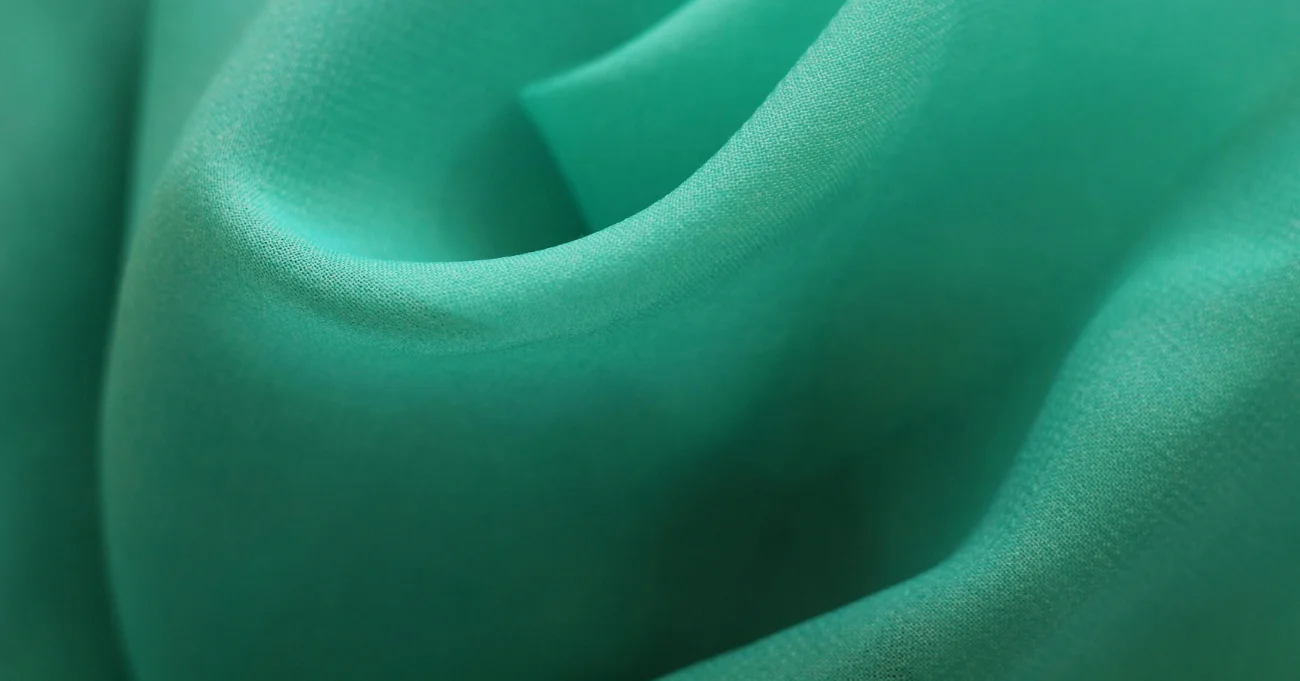Discovering what does polyester feel like in clothing can be an exciting journey, as it has a distinct touch. Polyester is a popular fabric with a smooth and slightly slick feel upon touch, making it a go-to choice for activewear and outdoor clothing. Running your fingers over it will give you a feeling of sleekness, incredibly different from natural fibers such as cotton or wool.
At ooShirts, we’re committed to highlighting polyester’s versatility and taking you on a journey with it. Our team is dedicated to making you competent with knowledge and inspired with ideas so that you can feel the texture of polyester in your fashion creations. We pioneer in crafting custom fabric designs of top-notch quality, providing you with resources to help you understand the polyester fabric sensation in your clothing projects.
Inspired by our extensive industry insights, we’ve made this guide to explain what does polyester feel like and compare it to other types of garments. We’ll also consider how to choose the most suitable fabric for your clothing and share ideas for creating custom t-shirt designs. By the end, you will learn what polyester feels like and how to utilize such characteristics for the most stunning fashion design.
Let’s get started!
Exploring Polyester Texture: What Does Polyester Feel Like?
Polyester fabric’s unique texture sets it apart, offering a smooth and luxurious feel favored in clothing. Its durability and resistance to wrinkles make it ideal for everyday wear. Check out these key features to figure out what does polyester feel like and and its popularity in the fashion textile industry:
1. Smoothness and Softness – Ensure Smooth Sensation for Every Touch
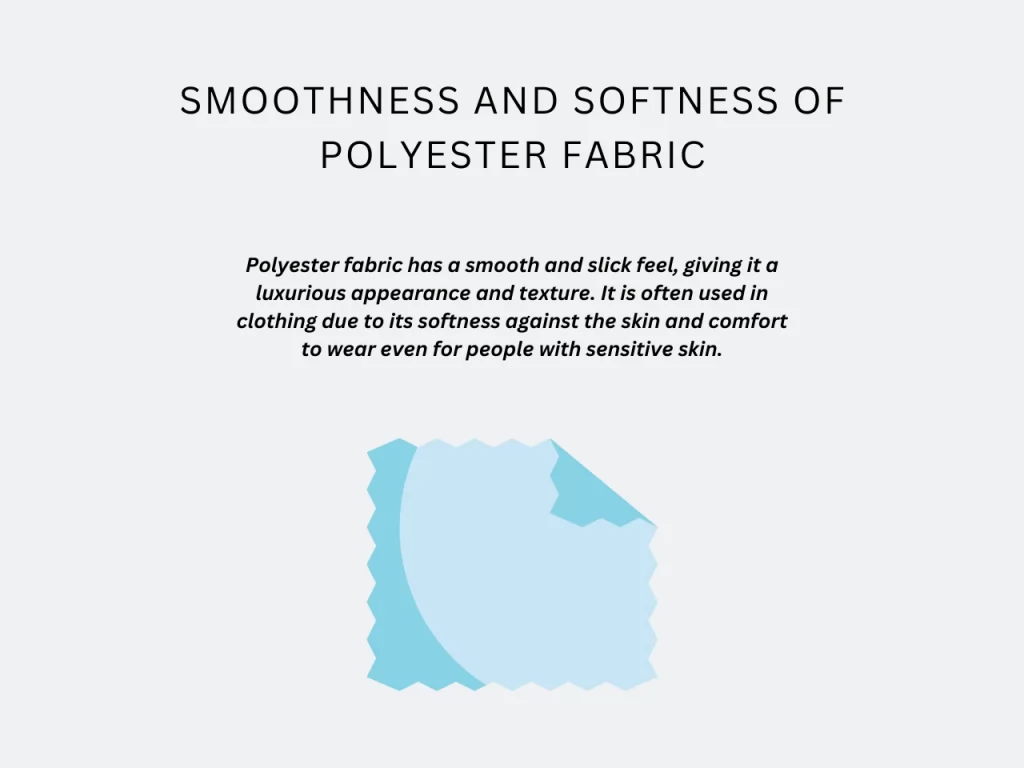
Polyester fabric is a material that has its very own specificity in terms of texture. It has a smooth and slick feel, which gives it a luxurious appearance and texture. This fabric is often used in clothing due to its softness against the skin and comfort to wear, making it suitable even for sensitive skin. The texture of the polyester fabric depends on its eave and overall finish.
A brushed polyester fabric has a slightly fuzzy texture, while satin polyester fabric is smooth and shiny. Softness and smoothness are regarded as two main attributes of polyester fabrics, making them highly demanded in manufacturing clothes and other textile products.
2. Durability and Resilience – Fortify Clothing with Strength
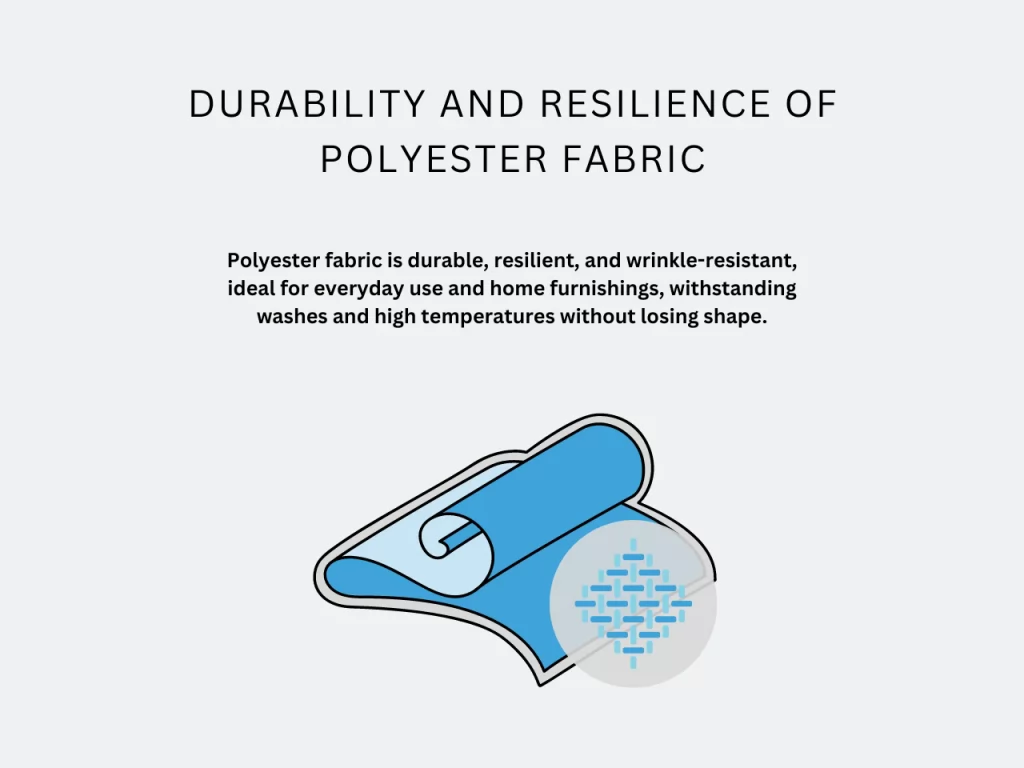
The strength of the polyester fabric lies in its remarkable ability to be both durable and resilient against multiple washes. Being synthetic gives it the strength to withstand high temperatures without losing its primary shape. This makes polyester garments solid and suitable for everyday and industrial use.
Polyester’s durability shines through in clothing or home furnishings, offering long-lasting performance. This resilience extends to its wrinkle resistance and ease of care. Hence, one can be sure it will remain in its top form even after continuous usage.
Types of Polyester and Their Feel
Polyester offers various types, each with unique advantages. From durable standard polyester to delicate microfiber and performance-oriented athletic polyester, exploring these varieties unveils the distinct feel they bring to comfort and performance. Discover what polyester feels like for each type to find the perfect match for your needs.
1. Standard Polyester – Offers Satisfaction That Stand Firm Through Time
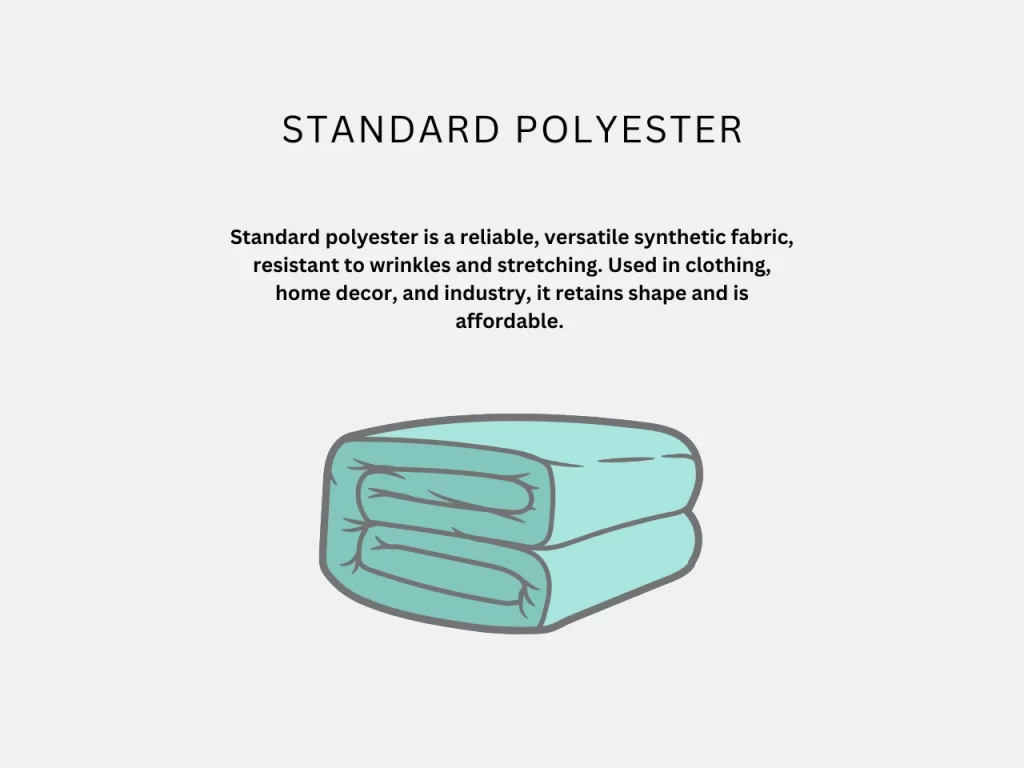
Standard polyester is the most common synthetic fabric, known for its reliability and versatility. Since the cloth is resistant to wrinkles and stretching, it has a variety of applications in clothing, home decoration, and industrial uses.
This type of polyester is created by synthesizing ethylene glycol and terephthalic acid. With its synthetic nature, standard polyester retains its shape well and is an affordable option for everyday wear. Its blend with other materials enhances its properties for various uses.
2. Microfiber Polyester – Highlights Delicate Feel for Everyday Comfort
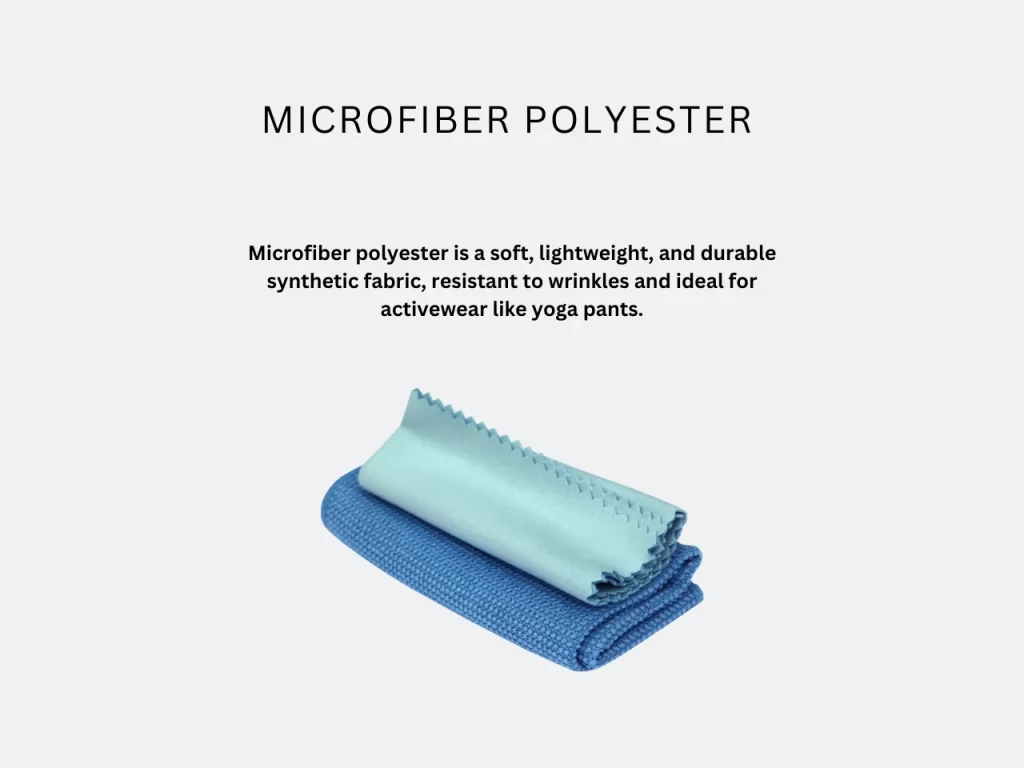
Microfiber polyester is a finely woven synthetic fabric known for its incredibly soft texture and lightweight feel. This polyester type is highly durable and resistant to wrinkles, making it a popular choice for polyester clothing items like activewear, including yoga pants.
The manufacturing process of microfiber polyester creates ultra-fine fibers that render outstanding elasticity and stretchiness. These qualities make it a good choice for sporting wear since it can absorb moisture from the skin.
3. Athletic Polyester – Prioritizes Comfort for Active Lifestyles
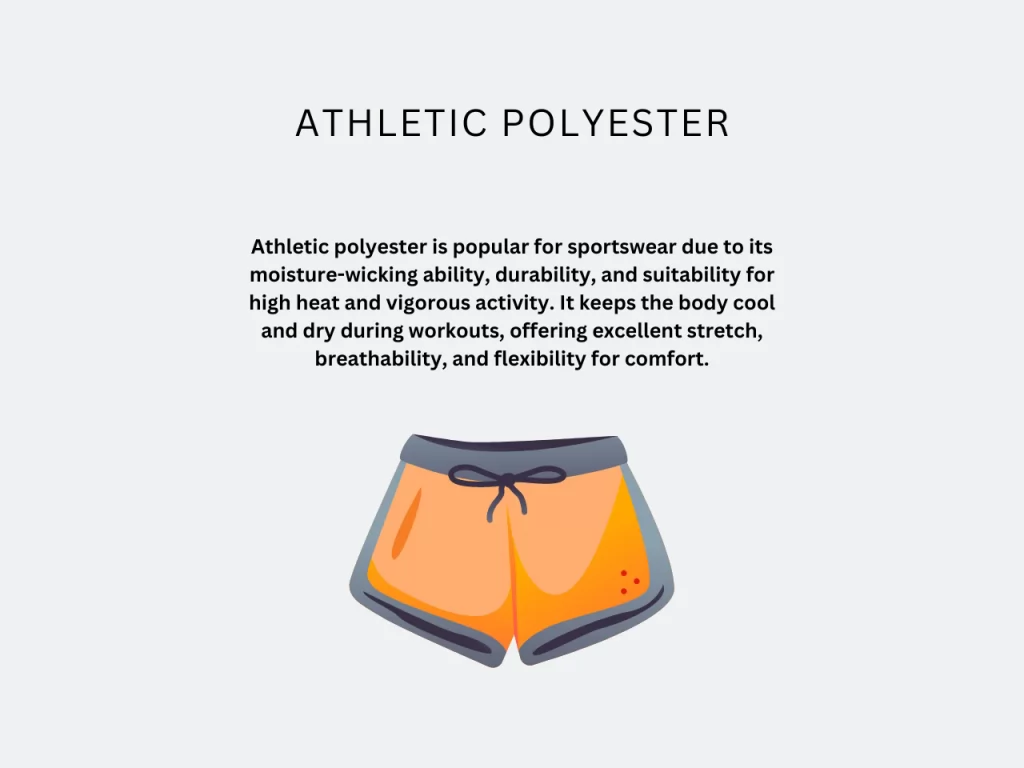
Athletic polyester is one of the popular synthetic fibers for sportswear due to its moisture-wicking ability and durability. This synthetic fabric is engineered for high heat and vigorous physical activity, making it best suited for yoga pants or dri-fit shirts as sportswear.
Athletic polyester fabrics keep the wearer’s body cool and dry by wicking away sweat during heavy workouts. With its excellent stretch and breathability, athletic polyester assures comfort and plenty of flexibility for anyone indulging in that sport.
Comparing Polyester to Other Fabrics: What Does Polyester Feel Like?
Polyester and various other fabrics offer distinctive features, catering to diverse needs in the fashion industry. Understanding what polyester feels like, along with the disparities between these materials, aids in making informed choices for garments. Dive into the comparison below to discern the optimal fabric type for your clothing needs.
1. Polyester vs. Cotton – Delivers a Soothing Touch Beyond Comparison
Both cotton and polyester have advantages, so they are popularly used for a wide range of applications. This mostly comes down to precisely what the wearers are looking for. Here are some main differences to help you choose the best fabric:
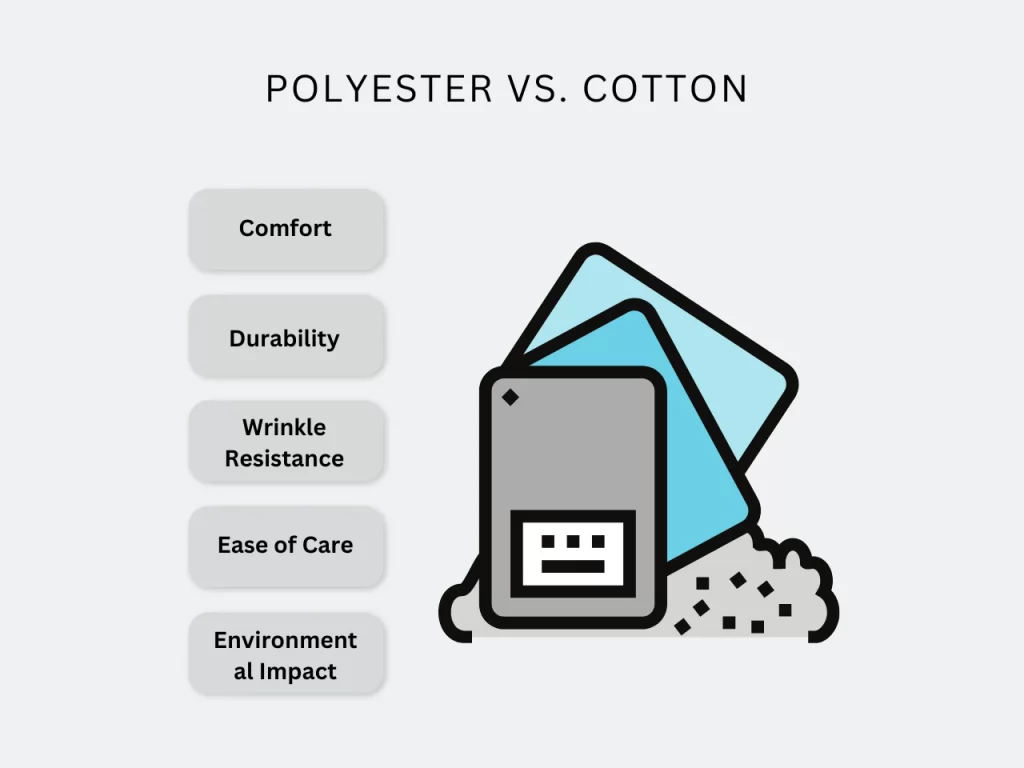
- Comfort: Cotton is very comfortable for everyday wear, especially in warm weather, due to its softness and natural feel. In contrast, polyester offers a smooth texture, which may not feel natural, but it is durable and resistant to wear.
- Durability: Polyester is a durable, resilient fabric that keeps its shape and color over time, even after multiple washes. While comfortable, cotton fibers often weaken with wear, particularly in high-use garments.
- Wrinkle Resistance: Polyester’s wrinkle resistance is excellent, especially when combined with materials in cotton blends. This makes it ideal for garments that look neat, not cluttered, and crispy. Cotton, on the other hand, may require more ironing or steaming to maintain a smooth appearance.
- Ease of Care: Polyester is easy to care for and needs little attention; it maintains its looks exceedingly well. Being comfortable and luxurious on the body, cotton may need more care not to shrink and wrinkle, thus making it not wear as long.
- Environmental Impact: Cotton fabric is a natural, biodegradable, and renewable fiber, making it an ecologically sound choice. However, its cultivation requires enormous amounts of water and pesticides. Polyester, derived from petroleum, is not biodegradable but is subject to new recycling technologies that make its use more sustainable.
2. Polyester vs. Silk – Bridges the Gap Between Practicality and Everyday Luxury
The properties of polyester and silk fabric differ. Their application also varies in the industry for different fashion fields. Here’s a breakdown of the critical distinctions, including how polyester feels compared to silk:
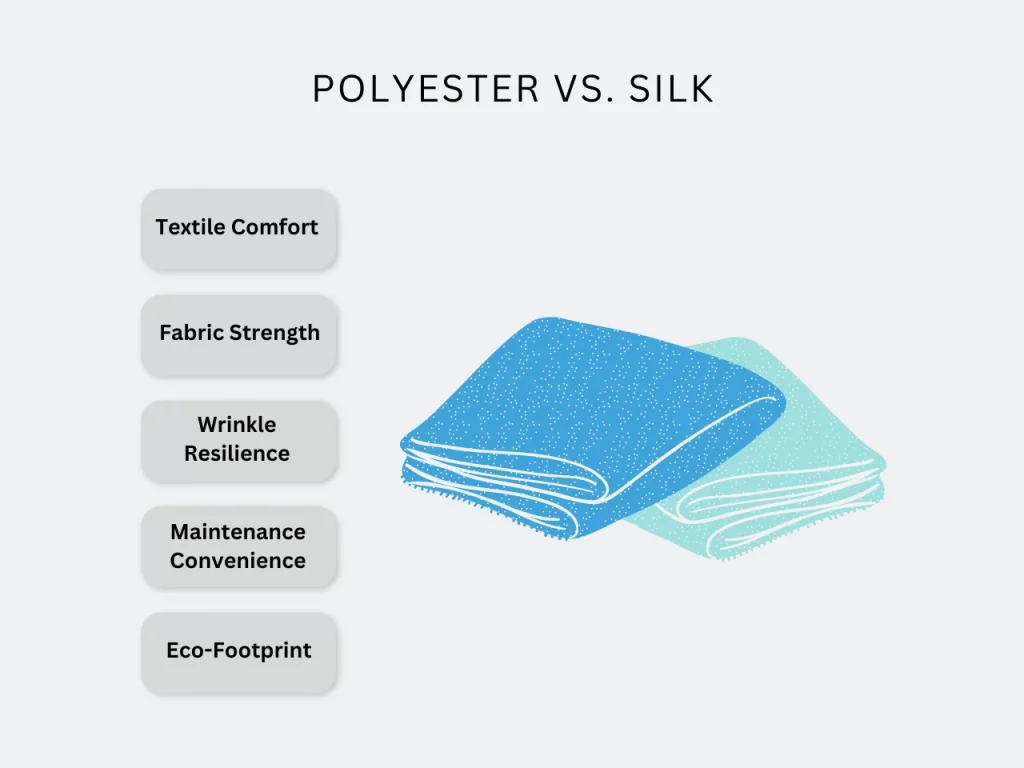
- Textile Comfort: Polyester feels smooth and comfortable for everyday use. Meanwhile, silk is luxurious with softness and a natural sheen, which best suits eminent occasions.
- Fabric Strength: Does polyester shrink? Polyester fabric is solid and resilient to wrinkles, stretching, and shrinking, making it a perfect choice for outdoor gear. Unlike its apparent fragility, silk is tough and long-lasting if handled carefully.
- Wrinkle Resilience: Due to their synthetic nature, polyester fabrics can retain their smooth appearance even after several washes, making them low-maintenance. On the other hand, silk wrinkles quickly, demanding careful handling and scrutiny to ensure it retains the same crisp appearance.
- Maintenance Convenience: Polyester can be machine-washed and comfortably tumble-dried without special treatment, making the garments convenient, especially for busy people. Unlike silk, which is often hand-washed or sent to the dry cleaner, polyester can be washed at home like other standard fabrics.
- Eco-Footprint: Polyester is derived from petrochemicals, meaning its eco-footprint is higher than natural silk fiber. This fabric contributes to problems such as microplastic pollution. While silk is biodegradable and environmentally friendlier, its production involves intensive farming practices.
3. Polyester vs. Wool – Keeps You Cozy and Itch-Free
When comparing polyester fabric to wool, significant differences emerge regarding their characteristics and applications in the fashion industry. Here’s an analysis of the critical disparities between these two fabrics:
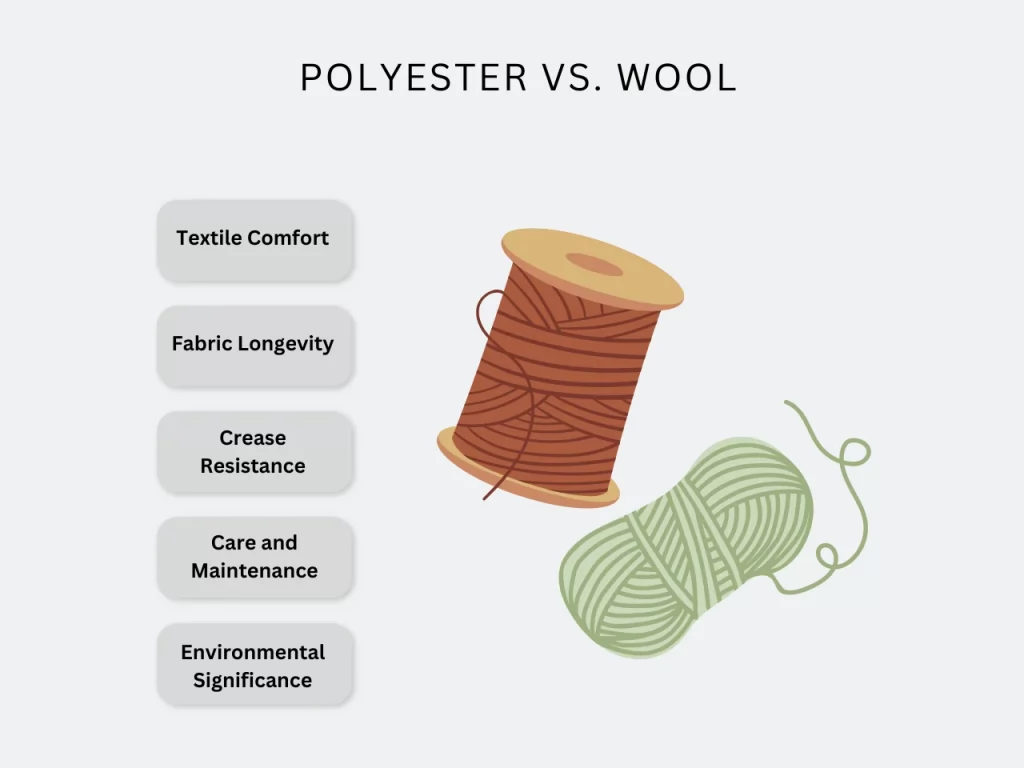
- Textile Comfort: Polyester boasts a smooth and comfortable texture suitable for everyday wear, while wool offers natural softness and warmth, ideal for colder climates and winter garments.
- Fabric Longevity: Polyester fabric excels in durability, resisting wrinkles, stretching, and shrinking, ensuring garments last longer. Conversely, wool, known for its resilience, provides strength and elasticity, particularly in high-quality clothes.
- Crease Resistance: Polyester fabric maintains a smooth appearance, even after multiple washes, making it low-maintenance. In contrast, wool’s natural resilience helps it resist wrinkles and creases, reducing the need for frequent ironing.
- Care and Maintenance: Polyester garments are easy to care for, as they can be machine-washed and dried without special treatment, offering convenience for regular use. However, wool requires more delicate care, often necessitating gentle hand washing or dry cleaning to maintain its texture and properties.
- Environmental Significance: Polyester, made from petrochemicals, has a larger ecological footprint than natural wool, adding to microplastic pollution. Wool, which is biodegradable and derived from sheep, is seen as more eco-friendly, though its production poses challenges like land and water use.
How To Choose the Right Polyester Fabric for Clothing and Custom Shirt Design
Choosing a suitable polyester fabric is essential if you want your creations to nail comfort, performance, and style. Understanding what does polyester feels like is vital, as there’s a whole spectrum of textures, weights, and stretchiness to consider. Discover these key steps to ensure you’re creating garments that look great and perform well:
Step 1: Consider the Purpose
Start your search by considering the purpose of the garment. Understanding the intended use will help you select the most suitable polyester type, ensuring comfort and performance according to your needs. Explore these considerations to ensure you’re making an informed decision that meets your comfort and performance standards:
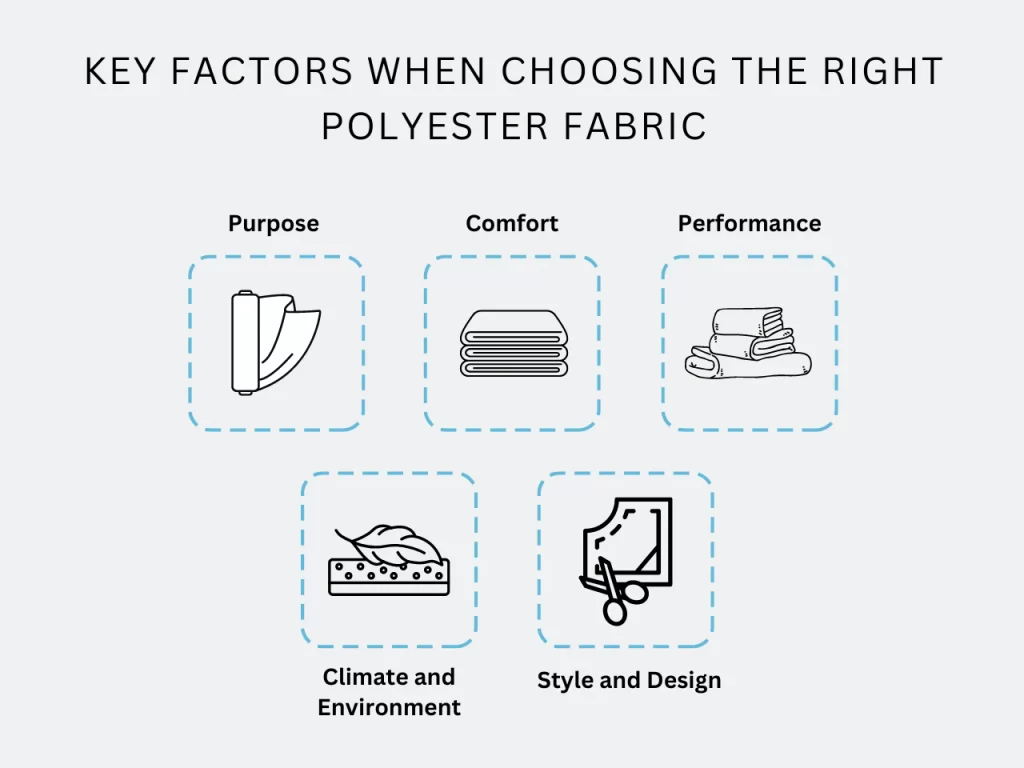
- Purpose: Understand what the garment will be used for so you can choose a polyester fabric that perfectly meets those needs.
- Comfort: Look for breathable, soft polyester fabrics with long threads and excellent moisture-wicking properties sourced from quality raw materials. These fabrics will keep you comfortable all day and minimize the risk of skin irritation.
- Performance: Choose a durable fabric with the right amount of stretch and resistance to wrinkles and stains, depending on how active you’ll be in the garment.
- Climate and Environment: Consider the weather and surroundings where you’ll wear the garment to ensure the polyester fabric suits those conditions.
- Style and Design: Find a polyester fabric that not only feels great but also complements the overall style and design of the garment you have in mind.
Step 2: Evaluate the Weight
The weight of polyester fabric is crucial when selecting clothes because it affects how they hang and feel. Lighter fabrics are ideal for breezy summer outfits like dresses or tops as they do not trap body heat, allowing airflow that keeps you cool. However, if you need something to keep you warm or add structure, heavier weights are more suitable, especially for jackets.
Knowing how polyester feels based on weight helps you select the perfect fabric for your needs, whether dressing for the day or decking out your space. It’s all about ensuring your clothes feel and work just how you want them to.
Step 3: Check the Stretch
Assessing the polyester stretch of the fabric is another vital step in choosing the suitable material for your clothing or creating custom shirt designs. The stretchiness of your polyester garments is essential in helping you choose the right ones for your specific needs. Here’s what to keep in mind when you’re checking out polyester fabrics for their stretchiness:
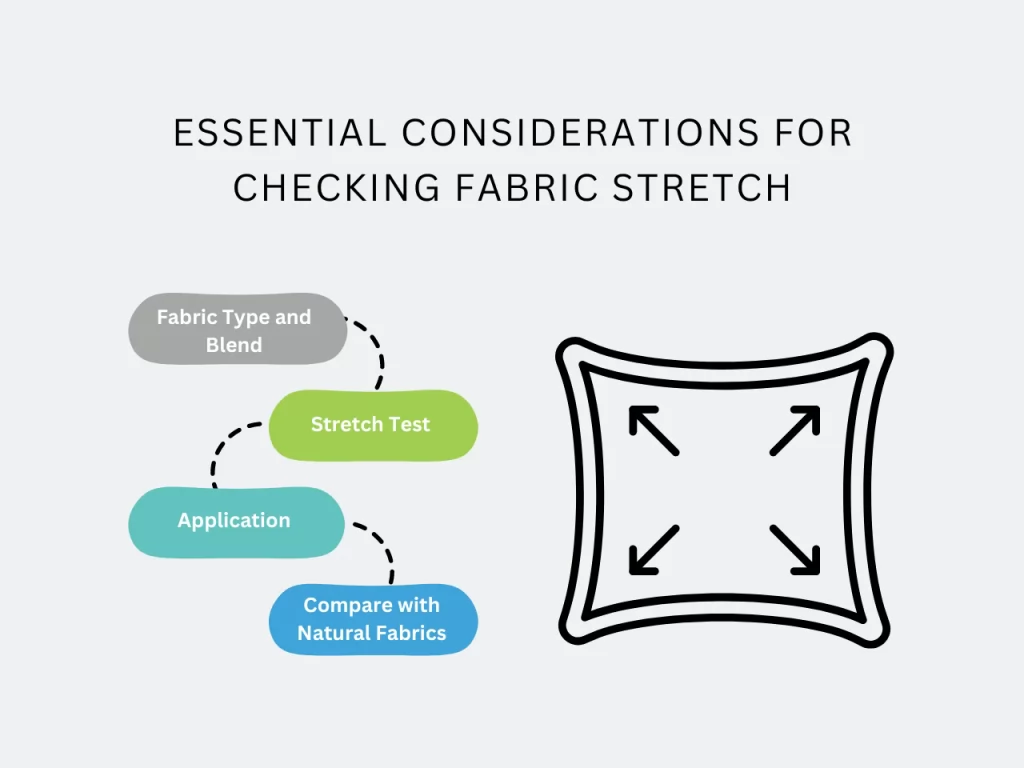
- Fabric Type and Blend: Different polyester fabrics and blends can have different levels of stretchiness. If you’re after that extra flex, look for fabrics blended with spandex or elastane—they’re usually the stretchiest.
- Stretch Test: Tug the fabric in different directions to see how stretchy it is. This little test will tell you how comfy and movable your clothes will be.
- Application: Think about what you’ll be using the garment for. Polyester’s stretchiness makes it a go-to for workout gear like yoga pants, where you need that extra give for all those bendy poses.
- Compare with Natural Fabrics: Contrast the stretch of polyester with natural fabrics like cotton or wool to determine the best fit for your comfort and performance requirements.
Step 4: Assess the Polyester’s Texture
Once you’re done checking the stretch of the fabric, it’s time to assess its texture for added comfort and tactile appeal in your clothing. Smoothness and softness are typical characteristics, offering a pleasant feel against the skin. Explore these factors to consider when assessing the texture of polyester fabrics:
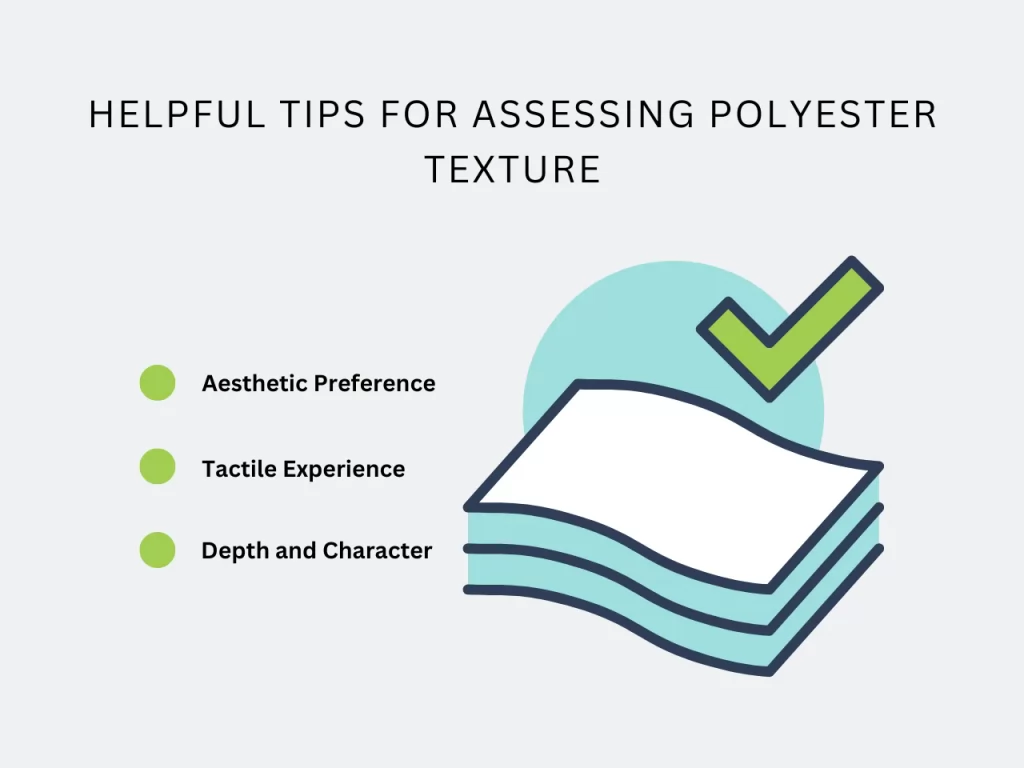
- Aesthetic Preference: Consider how you want your garment to look and feel. Polyester can mimic silk, cotton, or wool, so pick the one that matches your vibe.
- Tactile Experience: Consider how the polyester fabric feels to the touch. Smooth and shiny textures may be suitable for a formal look, while textured fabrics can create a more relaxed or casual vibe.
- Depth and Character: Texture adds depth and character to your design, enhancing its visual appeal. Evaluate how the texture of the polyester fabric complements the overall design aesthetic you’re aiming for.
Step 5: Examine Care Instructions
Taking care of your polyester clothes is effortless, but checking the care label for special instructions is always smart. Polyester is generally easy to maintain, as it is machine washable and quick-drying. To keep your polyester threads in top shape, simply toss them in on a gentle cycle with warm water and avoid high heat when drying to prevent shrinkage or mishaps.
Additionally, polyester fabrics are durable and wrinkle-resistant, making them practical choices for everyday wear. Knowing how polyester feels can help you understand its care needs, including considerations such as fabric softeners. Follow any extra tips from the manufacturer to keep your garments looking fresh for the long haul.
Step 6: Explore Apparel Stores and Custom Shirt Printing Partner
When exploring apparel stores and custom shirt printing partners, consider the variety of polyester fabric options available. These stores often offer polyester blend fabrics suitable for different clothing needs. Polyester garments range from casual to formal wear, making them versatile for custom designs.
Great options like ooShirts offer custom clothing made in polyester from reputable brands like Hanes, Nike, and Bella, providing a versatile choice for your custom designs or clothing preferences. Experimenting with different fabrics can offer valuable insights into printing or embroidery techniques, sparking new ideas for your creations.
Step 7: Request Fabric Samples
As you search for a suitable polyester fabric, don’t hesitate to ask for fabric samples before making a big purchase. Many suppliers offer this service for free or a nominal fee, enabling you to feel the texture, evaluate durability, and test the fabric’s stretch. Fabric samples help you make informed decisions, especially for custom shirt designs or clothing projects.
With samples in hand, you can test quality, texture, color accuracy, and how the fabric hangs. It’s a simple yet best way to ensure your final fabric choice meets your needs perfectly. Whether after something comfy for everyday wear, stretchy for your athletic adventures, or classy for a formal event, these samples are your trusty sidekick.
Key Takeaway
Exploring what does polyester feel like unveils a fabric that combines comfort and functionality. The fabric possesses a silky texture, offering a luxurious feel against the skin. Its lightweight nature adds to its appeal, providing ease of movement and breathability, which is ideal for various climates and activities.
Embracing polyester in your wardrobe means embracing versatility. Its ability to retain its shape and resist wrinkles ensures your garment maintains its pristine appearance wear after wear. Moreover, polyester’s quick-drying properties make it a top choice for those with active lifestyles, as it wicks away moisture, keeping you dry and comfortable throughout the day.
Eager to learn more about the luxurious feel of polyester fabrics? Reach out to us at [email protected] for personalized consultations tailored to your preferences. Explore our curated blogs on the ooShirts blog page for tips on incorporating polyester into your wardrobe. Let’s enhance your style and comfort with the luxurious touch of polyester fabrics.
